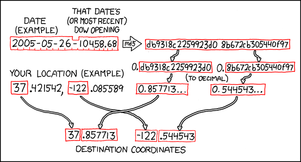Difference between revisions of "The Algorithm"
From Geohashing
imported>Tjtrumpet2323 m |
imported>Tjtrumpet2323 m |
||
| Line 5: | Line 5: | ||
* Strings of the current date (in yyyy-mm-dd format) and the daily opening price of the [[Dow Jones Industrial Average]] are concatenated, with a hyphen separating the two. | * Strings of the current date (in yyyy-mm-dd format) and the daily opening price of the [[Dow Jones Industrial Average]] are concatenated, with a hyphen separating the two. | ||
** If there is no opening price for the Dow, the opening price from its previous day of active trading is used instead. | ** If there is no opening price for the Dow, the opening price from its previous day of active trading is used instead. | ||
| − | * The resulting string is then fed through the well-documented [[wikipedia:MD5|MD5]] cryptographic algorithm to generate as pseudo-random "hash" of 32 hexadecimal digits. | + | * The resulting string is then fed through the well-documented [[wikipedia:MD5|MD5]] cryptographic algorithm to generate as pseudo-random, yet easily verifiable, "hash" of 32 hexadecimal digits. |
* The "hash" is then split into two halves of 16 hexadecimal digits. | * The "hash" is then split into two halves of 16 hexadecimal digits. | ||
* Each half of the "hash" is prepended with a decimal point (so as to represent a hexadecimal fraction) and is converted to a base-10 fraction. | * Each half of the "hash" is prepended with a decimal point (so as to represent a hexadecimal fraction) and is converted to a base-10 fraction. | ||
Revision as of 22:38, 23 May 2008
This time, we did invent the algorithm!
- Strings of the current date (in yyyy-mm-dd format) and the daily opening price of the Dow Jones Industrial Average are concatenated, with a hyphen separating the two.
- If there is no opening price for the Dow, the opening price from its previous day of active trading is used instead.
- The resulting string is then fed through the well-documented MD5 cryptographic algorithm to generate as pseudo-random, yet easily verifiable, "hash" of 32 hexadecimal digits.
- The "hash" is then split into two halves of 16 hexadecimal digits.
- Each half of the "hash" is prepended with a decimal point (so as to represent a hexadecimal fraction) and is converted to a base-10 fraction.
- The resulting decimal fractions are appended to the integral (lat,lon) values of any given graticule to produce that graticule's geohash target for the day.
Fractional hexadecimal to decimal calculation
Many online hex-to-dec converters do not support hexadecimal fractions. Here is one that does:
